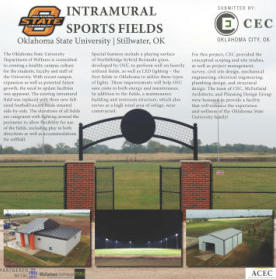
2016 Engineering Excellence Awards
2016 Grand Conceptor
Guernsey Honored as Engineering Excellence Award "Grand Conceptor" For Boeing Office & Electronics Laboratory Facility, Oklahoma City
In February 2015 The Boeing Company (Boeing) contracted Guernsey to masterplan a campus and design the first phase of the project—a 316,000-square-foot, two- story office and laboratory facility adjacent to Tinker Air Force Base. This expansion was programmed to bring over 800 high paying engineering and technical jobs to the greater Oklahoma City area. The project kicked off on April 1, 2015 with a critical move-in date of May 1, 2016.
The project consisted of consolidating 30 laboratories and functions from multiple Boeing locations nationwide. The challenge that Guernsey had from the beginning was meeting the requirements for laboratories with varying functions with a single design solution for mechanical, electrical and plumbing infrastructure.
The building HVAC systems and electrical systems were chosen to be as flexible and powerful as possible to provide a reasonable amount of redundancy as well as service for future phases of growth. Guernsey designed a chilled water system utilizing a variable primary system to meet HVAC needs. The tightly coordinated electrical system was designed to use multiple utility feeds rather than on-site generation. Guernsey had to utilize some of the largest available distribution equipment to meet Boeing’s power requirements. Through the team’s up-front planning and design, the facility’s complex electrical is both extremely safe and highly reliable.
Physical secrecy and security was a primary driver of many decisions and construction of systems. Each space had to be analyzed based on classification requirements and adjacencies. The facility was also hardened to withstand up to an EF4 tornado in order to protect its employees and high-value aeronautical laboratory equipment.
Guernsey was able to meet and exceed the client’s expectations and provide innovative solutions for each issue that was presented during design and construction of the facility. Due to the robust nature of the systems that Guernsey provided in design, Boeing expects the building to last and serve them well for now and into the future.

2016 Honor Award Winners
CEC - OSU Intramural Sports Fields
Campus expansion had created the need to both replace an existing intramural field and provide additional facilities to allow for future growth.
The new North Intramural Fields will help the Oklahoma State University Department of Wellness serve more than 3,500 weekly participants in its Intramural Sports program. The site features three, full sized football/soccer fields situated side by side.
The fields are common in elevation and lighting is positioned only around the perimeter. This allows for play in any direction and for the fields to be oriented for softball use as well.
Other features include a playing surface of NorthBridge™ hybrid Bermuda grass, developed by OSU to perform on heavily utilized sports fields such as these, and the fields are the first in Oklahoma to employ LED sports lighting. This will help OSU to achieve savings in both energy and maintenance costs.
In addition to the fields, a maintenance building and restroom structure, which also will serve as a high wind area of refuge, have been constructed on site. Utilities and stormwater detention for these facilities was designed in a manner to allow for the placement of additional developments in the future. CEC provided conceptual scoping and site studies for this project as well as overall project management; survey, civil site design; mechanical, electrical, and plumbing design; and structural design.
Team members included McFarland Architects and Planning Design Group. The $3.5 million project stands ready to help the OSU Department of Wellness achieve its commitment to creating a healthy campus culture for students, faculty, and staff.

Olsson Associates - Emergency Repair of May Avenue Bridge over Northwest Expressway
On May 19, 2016 an over-height vehicle travelling westbound on Northwest Expressway in Oklahoma City impacted the exterior beam in Span 3 of the May Avenue Bridge, causing partial collapse of that span. The bridge and road below were immediately closed to traffic in all directions until the damaged section and debris could be removed and an evaluation of the remaining structure could be completed.
Representatives from Olsson Associates were on site within an hour after the incident and performed an assessment of the bridge to ensure safety of the driving public. Olsson Associates assisted the City in advising Cimarron Construction on the demolition of the collapsed bridge to best preserve the remaining structure. Removal of the damaged portions began on May 20 and was completed May 21. During the afternoon of May 21, Olsson Associates performed a thorough visual inspection of the bridge structure for any damages from the collision and found the southbound lanes to be safe to open to traffic.
Due to the location of the project and the importance of both Northwest Expressway and May Avenue to the surrounding community, the demolition and repair efforts needed to be done quickly and efficiently, with as little impact to the local community as was possible. The City requested that the damaged bridge span be replaced and look similar to the original structure. With this in mind, and in an effort to keep repair time and construction costs down, Olsson directed Cimarron Construction to salvage and re-use the original ornamental railing.
In addition to allowing limited traffic on the bridge during reconstruction, a temporary crossover was constructed to detour westbound traffic on Northwest Expressway on the eastbound lanes. Because of this, local traffic was only slightly impeded during repairs.
Repair construction plans were completed and submitted to the City within a week of the initial damage, after which the project was awarded to the low-bidder, Cimarron Construction Company. Final inspection was performed on July 22, 2016, and both May Avenue and Northwest Expressway returned to normal operation.

Olsson Associates - Western Road Widening
The City of Stillwater is home to Oklahoma State University, which has been growing over the past several years. This growth has expanded from campus, spurring development within the city. There has been increased residential development, university expansion and a new commercial airline service on the west side of the Oklahoma State University campus. Western Road is located on the west side of the Oklahoma State Campus and as a 2 lane road with minimal shoulders, it is not keeping up with the times. The City of Stillwater hired Olsson Associates to develop the plans to improve the roadway to keep up with the development in the area; however, it was not just the City of Stillwater that was involved. The project included multiple agencies: Oklahoma State University, the Oklahoma Department of Transportation, the Natural Resource Conservation Service (NRCS) and the Payne County Conservancy District.
The project included the realignment and widening of Western Road to align with Farm Road to create a new single signalized intersection with Hall of Fame. The majority of the roadway is located within the drainage basin of a NRCS flood control structure which resulted in several challenges. The improvements to the roadway included a bridge, a new signal, improved sight distance and safety.
One of the challenges of the project was to not impact the capacity or the function of the dam. 3D modeling was done to ensure the dam would not be impacted. Additionally, the main communication line that provided internet access to the university went through the site, resulting in several meetings and intentional design to accommodate the location of that vital utility.
Overall, the success of this project is due to the collaboration and cooperation of the multiple agencies that were involved. Because everyone worked together for a common goal, this project will be a success to the many individuals that played a part.

Terracon - Geophysical Survey Limits Karst Formation Impact Study in Major & Woodward Counties
The US-412 corridor in Major and Woodward Counties is a major truck route through northern Oklahoma carrying freight from the Port of Catoosa, near Tulsa, westward to Denver. US-412 carries a traffic volume in excess of 2,350 vehicles per day (VPD) with 35 percent being heavy trucks. Until recent improvements along the corridor, much of US-412 consisted of a narrow two-lane highway with minimal or no shoulders, inadequate safety slopes and poor site distance.
These sections of US-412 were the most challenging parts of the corridor to design and construct due to the rolling hills and regional geology which is intermixed with three prominent gypsum beds containing numerous solution cavities and caves that serve as nesting areas for bats and favorite exploration sites for local spelunker clubs.
ODOT tasked Terracon Consultants, along with internal staff, Garver and MacArthur Associated Consultants to design functional improvements necessary to the highway within a limited budget. The design work began with geophysical survey mapping potential voids and cave features and several geotechnical borings.
The geophysics engineers and geotechnical engineers worked closely with the roadway design engineers and ODOT staff as they considered several alignment alternatives and typical sections. Final designs included various options to minimize the impact of the new vertical alignment on the karst topography and assure the prolonged sustainability of the highway.
The geophysical surveys and related geotechnical borings successfully captured the unique anomalies of the karst topography. While considerable effort was expended during the design phase collecting the geophysical data, doing so allowed construction to proceed smoothly, with minimal interruptions.

